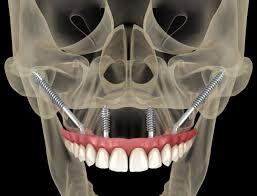Zygomatic implants represent a significant advancement in the field of dental rehabilitation, particularly for patients with severe maxillary atrophy or those who have undergone maxillectomy. Their unique anchorage in the zygomatic bone allows for immediate loading and restoration, which is a critical advantage over traditional implant techniques that often require extensive bone grafting and prolonged healing times. This capability not only enhances patient satisfaction through quicker restoration of function and aesthetics but also reduces the overall treatment duration and associated costs [1-3].
One of the primary benefits of zygomatic implants is their ability to provide a graftless solution for patients with insufficient bone volume in the maxilla. Conventional implants typically necessitate bone augmentation procedures, which can complicate treatment and increase morbidity [4,5]. In contrast, zygomatic implants can be placed directly into the zygomatic bone, allowing for the immediate provision of a provisional prosthesis within 24 hours post-surgery [3,6]. This immediate loading capability is particularly advantageous in clinical scenarios where rapid rehabilitation is essential, such as in patients recovering from oncological surgeries or those with congenital defects [7,8].
Furthermore, zygomatic implants have demonstrated high success rates comparable to conventional implants. Studies indicate that the survival rates of zygomatic implants are robust, with long-term follow-ups showing cumulative survival rates exceeding 95% [9,10]. This reliability is crucial for clinicians and patients alike, as it underscores the viability of zygomatic implants as a long-term solution for dental rehabilitation. Additionally, the use of advanced imaging and planning technologies has further optimized the placement of zygomatic implants, enhancing surgical precision and outcomes [11,12].
The versatility of zygomatic implants also extends to various prosthetic options, including bar-retained overdentures and hybrid prostheses, which can be tailored to meet individual patient needs [4,6]. This adaptability not only improves functional outcomes but also addresses aesthetic concerns, allowing for a more natural appearance in the final restoration. Moreover, the reduced need for multiple surgical interventions associated with zygomatic implants minimizes patient discomfort and recovery time, making them an appealing option for many patients [1,13].
In summary, zygomatic implants are poised to become the future of full-arch restorations due to their ability to provide immediate, reliable, and aesthetically pleasing solutions for patients with significant maxillary deficiencies. Their advantages over traditional methods—including reduced treatment time, lower morbidity, and high success rates—position them as a transformative option in dental implantology.
References
- Arcuri, L. Dental Implants in Patients With Ectodermal Dysplasia: A Computer Guided Quad Zygomatic Case Report and Literature Review. Odovtos – International Journal of Dental Sciences 2023, 10.15517/ijds.2023.56890, 11-24, doi:10.15517/ijds.2023.56890.
- Beri, A. Quad Zygoma: A Graftless Solution in Post-Mucormycosis Maxillectomy. Cureus 2023, 10.7759/cureus.50014, doi:10.7759/cureus.50014.
- Pérez, A.S. Success Rates of Zygomatic Implants for the Rehabilitation of Severely Atrophic Maxilla: A Systematic Review. Dentistry journal 2022, 10, 151, doi:10.3390/dj10080151.
- Shetty, O. Prosthetic Treatment Modalities on Zygomatic Implants: A Review. Dental Journal of Advance Studies 2023, 11, 124-127, doi:10.5005/djas-11014-0026.
- Venkatachalam, V. Evaluation of Surgical Outcomes of Zygomatic Implant-Supported Rehabilitation of Atrophic Maxillary Arches – A Prospective Study. Annals of maxillofacial surgery 2024, 14, 27-32, doi:10.4103/ams.ams_32_23.
- Lombardo, G.; Pardo, A.; Mascellaro, A.; Corrocher, G.; Marincola, M.; Costantinescu, F.-E.; Nocini, P.F. Rehabilitation of Severely Resorbed Maxillae With Zygomatic Implants: A Literature Review. Stomatology Edu Journal 2015, 2, 69-78, doi:10.25241/stomaeduj.2015.2(1).art.9.
- Gseibat, M. Immediate Loading of Zygomatic Implants Using a Dual Scan Technique. Journal of clinical medicine 2023, 12, 7464, doi:10.3390/jcm12237464.
- Romeed, S.; Malik, R.; Dunne, S. Zygomatic Implants: The Impact of Zygoma Bone Support on Biomechanics. Journal of Oral Implantology 2014, 40, 231-237, doi:10.1563/aaid-joi-d-11-00245.
- Moraschini, V.; Queiroz, T.R.d.; Sartoretto, S.C.; Almeida, D.; Calasans-Maia, M.D.; Louro, R.S. Survival and Complications of Zygomatic Implants Compared to Conventional Implants Reported in Longitudinal Studies With a Follow‐up Period of at Least 5 years: A Systematic Review and Meta‐analysis. Clinical implant dentistry and related research 2022, 25, 177-189, doi:10.1111/cid.13153.
- Roper, M.B.; Vissink, A.; Dudding, T.; Pollard, A.J.; Gareb, B.; Malevez, C.; Balshi, T.J.; Brecht, L.E.; Kumar, V.; Wu, Y., et al. Long-Term Treatment Outcomes With Zygomatic Implants: A Systematic Review and Meta-Analysis. International Journal of Implant Dentistry 2023, 9, doi:10.1186/s40729-023-00479-x.
- Grecchi, F. Guided Zygomatic Implantology for Oral Cancer Rehabilitation: A Case Report. Journal of clinical medicine 2023, 12, 3653, doi:10.3390/jcm12113653.
- Guanuchi, D.M.M.; Vera, E.D.Á.; Manzini, R.; Cicareli, A.J.; Kassis, E.N. Major Clinical Outcomes for Optimization of Zygomatic Implants: A Systematic Review. Mednext Journal of Medical and Health Sciences 2022, 3, doi:10.54448/mdnt22s409.
- Cosola, M.D.; Ballini, A.; Zhurakivska, K.; Ceccarello, A.; Nocini, R.; Malcangi, A.; Mori, G.; Muzio, L.L.; Cantore, S.; Olivo, A. Retrospective Analysis of Clinical and Radiologic Data Regarding Zygomatic Implant Rehabilitation With a Long-Term Follow-Up. International Journal of Environmental Research and Public Health 2021, 18, 12963, doi:10.3390/ijerph182412963.



